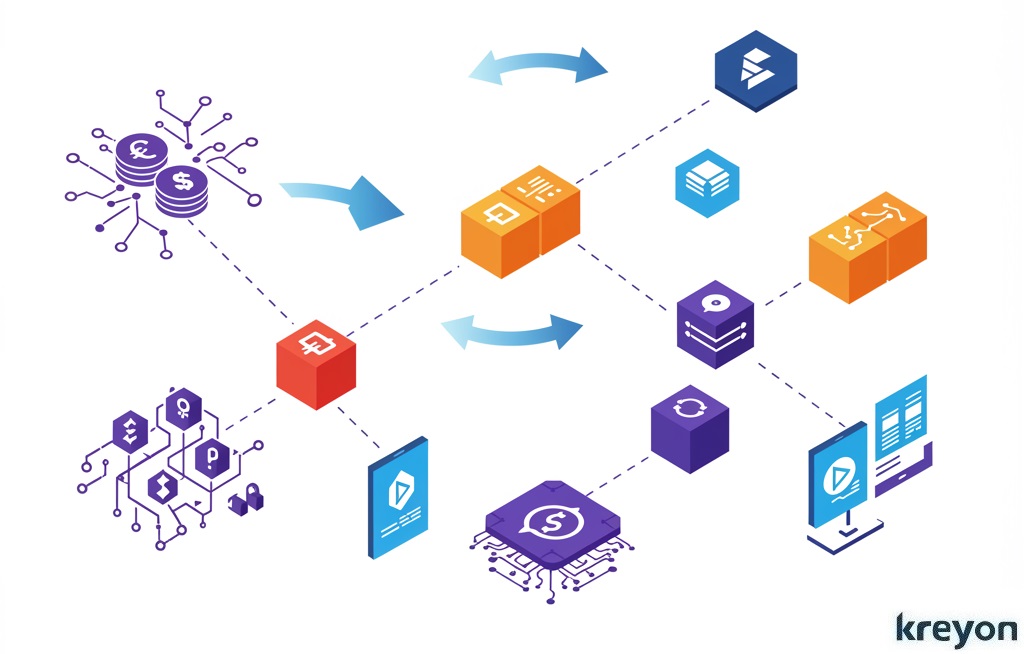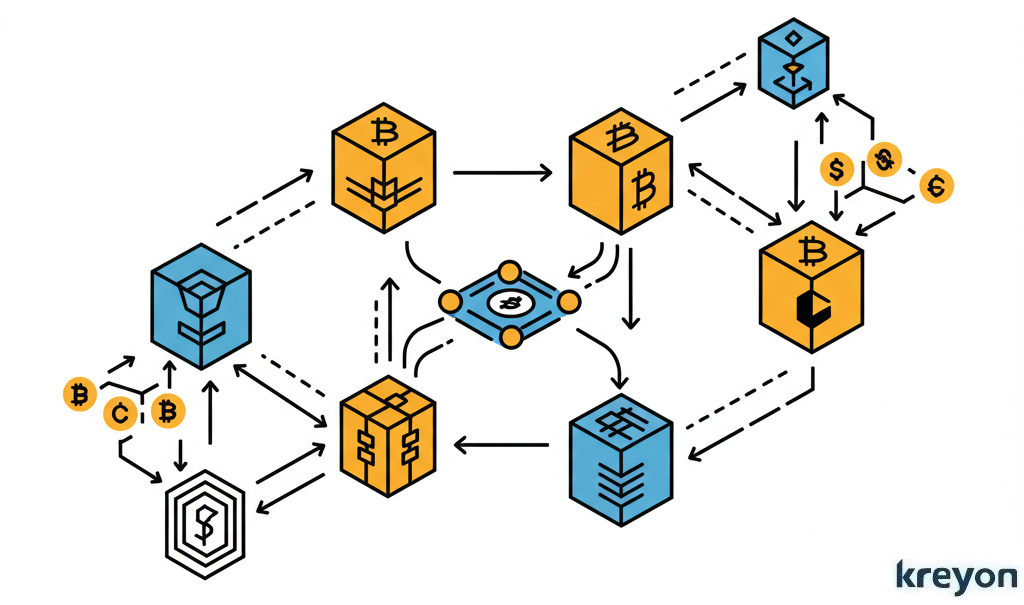Cross-Chain DeFi: Developing Interoperable Applications in a Multi-Chain World

The decentralized finance (DeFi) landscape has evolved rapidly, transitioning from single-chain ecosystems to a multi-chain world where interoperability is key. Cross-chain DeFi has emerged as a transformative solution, enabling seamless interaction between disparate blockchain networks.
As decentralized finance (DeFi) continues to evolve at breakneck speed, one major challenge is becoming increasingly clear: interoperability.
While Ethereum pioneered the DeFi movement, the emergence of multiple high-performance blockchains—like Binance Smart Chain, Avalanche, Solana, and Polkadot—has created a fragmented ecosystem. In this multi-chain world, the need for cross-chain DeFi applications is not just a luxury—it’s a necessity.
In this blog post, we explore how cross-chain DeFi is reshaping the industry, the technology behind it, and how developers can build truly interoperable DeFi apps that unlock new levels of efficiency, user access, and liquidity.
What is Cross-Chain DeFi?
Cross-chain DeFi refers to decentralized finance applications that operate across multiple blockchain networks, allowing assets, data, and smart contracts to interact seamlessly.
Unlike traditional DeFi, which is often confined to a single blockchain (e.g., Ethereum), cross-chain DeFi leverages interoperability protocols to connect ecosystems like Ethereum, Binance Smart Chain, Solana, Polkadot, and Cosmos.
The core idea is to break down silos between blockchains, enabling users to transfer tokens, execute cross-chain smart contracts, and access liquidity pools across different networks.
This fosters a more inclusive and efficient DeFi ecosystem, where users can capitalize on the unique strengths of each blockchain, such as Ethereum’s robust security or Solana’s high throughput.
The Need for Cross-Chain Interoperability
Traditional DeFi applications are often confined to a single blockchain, limiting their reach and functionality. Users may find it cumbersome to transfer assets between different blockchains, leading to fragmented liquidity and missed opportunities.
Cross-chain interoperability addresses these issues by allowing dApps to interact with multiple blockchains, thereby:
Enhancing Liquidity: By tapping into liquidity pools across various blockchains, DeFi applications can offer better rates and more options to users.
Expanding User Base: Users are not restricted to a single blockchain, broadening the potential audience for DeFi platforms.
Increasing Resilience: Distributing operations across multiple blockchains can reduce the risk of systemic failures.
Fostering Innovation: Developers can leverage the unique features of different blockchains to create more sophisticated and diverse financial products.
User Experience: Users must navigate multiple wallets and interfaces to interact with different blockchains.
Scalability Constraints: Single chains face bottlenecks in transaction speed and cost, limiting DeFi adoption.
Cross-chain DeFi addresses these issues by creating a unified ecosystem where assets and services flow freely. This not only enhances user experience but also drives innovation by allowing developers to combine the best features of multiple blockchains.
Core Components of Cross-Chain DeFi
To build effective cross-chain DeFi applications, several key components and technologies are essential:
1. Cross-Chain Bridges
Bridges facilitate the transfer of assets and data between different blockchains. They lock assets on the source chain and mint equivalent tokens on the destination chain, enabling seamless movement of value.
However, bridges can be vulnerable to attacks, making security a paramount concern. Implementing robust security measures, such as multi-signature wallets and time-lock contracts, is crucial to protect user assets.Popular bridges include:
Wormhole: Connects Ethereum, Solana, and other chains for asset transfers.
Multichain: Supports cross-chain swaps across dozens of networks.
Polkadot’s XCM: Enables interoperability within the Polkadot ecosystem.
Bridges are critical for cross-chain DeFi, as they enable liquidity to move freely, supporting use cases like cross-chain lending and yield farming.
2. Interoperability Protocols

Protocols like Cosmos’ Inter-Blockchain Communication (IBC) and Polkadot’s relay chains provide frameworks for different blockchains to communicate and share data.
These protocols standardize interactions, making it easier for developers to build cross-chain applications. Examples include:
Polkadot: Uses a relay chain to connect parachains, enabling cross-chain smart contract execution.
Cosmos: Employs the Inter-Blockchain Communication (IBC) protocol for secure data and asset transfers.
Chainlink CCIP: Facilitates cross-chain messaging and token transfers with robust security.
These protocols ensure that cross-chain DeFi applications can operate reliably, even across blockchains with different consensus mechanisms.
3. Atomic Swaps
Atomic swaps enable direct peer-to-peer exchanges of assets between different blockchains without the need for intermediaries. Using hashed timelock contracts, atomic swaps ensure that transactions are either completed in full or not at all, reducing counterparty risk.
4. Oracles for Data Integrity
Oracles provide external data to smart contracts, enabling them to react to real-world events.
In a cross-chain context, oracles can supply information about the state of assets on different blockchains, ensuring that transactions are executed correctly.
Using decentralized oracle networks like Chainlink can enhance the reliability and security of data feeds.
Oracles like Chainlink provide reliable off-chain and cross-chain data, essential for pricing, collateral valuation, and smart contract execution. Ensure your application integrates trusted oracle networks.
5. Smart Contracts
Smart contracts are self-executing contracts with the terms of the agreement directly written into code.
For cross-chain DeFi, smart contracts must be designed to interact with multiple blockchains, handle different consensus mechanisms, and ensure secure execution of transactions.
Modular design, event logging, and error handling are essential considerations in smart contract development.
Building Cross-Chain DeFi Applications
Developing cross-chain DeFi applications involves several steps:
1. Selecting Compatible Blockchain Networks
Choose blockchains that support interoperability standards and have active ecosystems. Consider factors like consensus mechanisms, transaction speeds, fees, and developer support.
Networks like Ethereum, Binance Smart Chain, and Avalanche are popular choices for DeFi applications.
2. Designing the Cross-Chain Architecture
Develop a system that allows different blockchain networks to communicate and interact with each other.
This involves integrating interoperability protocols, implementing atomic swaps, and ensuring secure asset transfers. Utilize middleware solutions to handle data translation and transaction validation.
3. Implementing Security Measures

Security is paramount in cross-chain DeFi applications. Implement encryption protocols, multi-signature authentication, and conduct regular security audits to identify and mitigate potential vulnerabilities. Utilize decentralized oracles and consensus mechanisms to enhance the integrity of cross-chain transactions.
4. Developing the User Interface (UI)
Create an intuitive and responsive UI that allows users to interact with multiple blockchains seamlessly. Integrate blockchain wallets and provide clear information about transaction statuses and fees. A user-friendly interface enhances engagement and fosters trust among users.
Simplify the user experience by abstracting away cross-chain complexities. Use intuitive interfaces, unified wallets, and gas fee subsidies to make interactions seamless.
5. Testing Across Chains
Thoroughly test the cross-chain application in a controlled environment using testnets. Simulate various scenarios to ensure the system’s reliability and security. Once testing is complete, deploy the application to the mainnet and continuously monitor its performance.
Thoroughly test your application on testnets for all target blockchains. Simulate cross-chain transactions, edge cases, and failure scenarios to ensure robustness.
Challenges and Considerations

While cross-chain DeFi offers numerous benefits, it also presents several challenges:
Security Risks: Bridges and oracles can be vulnerable to attacks, leading to potential loss of assets. Implementing robust security measures is essential to mitigate these risks.
Regulatory Compliance: Different blockchains may operate under varying regulatory frameworks. Ensuring compliance across jurisdictions can be complex and requires careful planning.
Scalability: Handling a large volume of cross-chain transactions can affect performance, latency, and cost-efficiency with growing data footprint.
As cross-chain DeFi spans multiple jurisdictions, it faces complex regulatory scrutiny. Developers must stay informed about compliance requirements to avoid legal pitfalls.
The Future of Cross-Chain DeFi
As the blockchain industry matures, cross-chain DeFi is poised to become the backbone of decentralized finance. Emerging trends include:
Zero-Knowledge Proofs: Enhancing privacy and security in cross-chain transactions.
Layer-0 Solutions: Protocols like Polkadot and Cosmos will further streamline interoperability.
AI-Driven DeFi: AI could optimize cross-chain yield strategies and risk management.
Institutional Adoption: Cross-chain DeFi could attract institutional capital by offering diversified, scalable solutions.
Developers who master cross-chain DeFi development will be at the forefront of this transformation, building applications that redefine how value flows in a multi-chain world.
Conclusion
Cross-chain DeFi is revolutionizing decentralized finance by enabling interoperability, enhancing liquidity, and unlocking new possibilities for developers and users.
While challenges like security and complexity remain, the benefits of a connected, multi-chain ecosystem are undeniable.
By leveraging the right tools, protocols, and best practices, developers can build robust, user-friendly applications that thrive in this dynamic landscape.
Kreyon Systems is a global technology company helping enterprises build scalable, secure, and innovative Web3 products—from smart contracts to full-stack DeFi platforms. For queries, please contact us.
